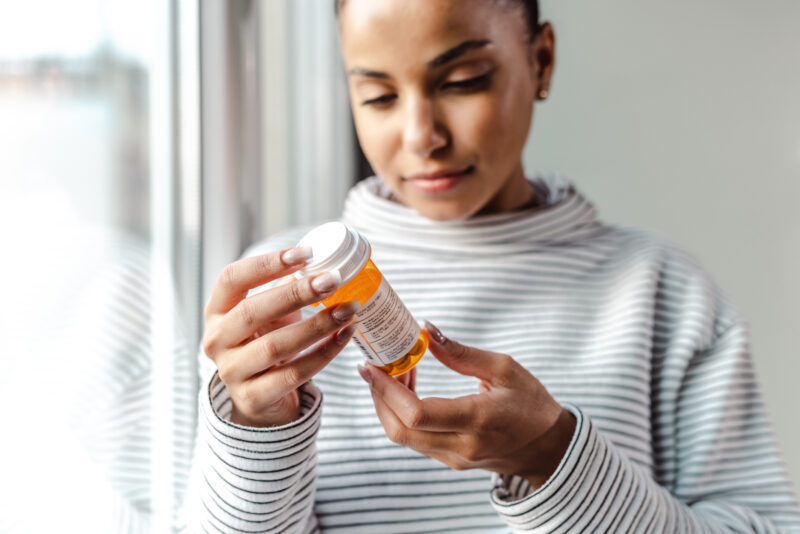
Table of Contents
How Long Does It Take for Suboxone to Start Working?

Written By: Ashley Laderer

Clinically Reviewed By: Cecilia Masikini
June 10, 2025
6 min.
Are you considering Suboxone treatment? Keep reading to learn about how long it takes Suboxone to kick in, how the medication works, and more.
Learn more about our Clinical Review Process
Table of Contents
Many people recovering from opioid use disorder (OUD) benefit from medication-assisted treatment, also known as MAT. One common medication used for medication-assisted treatment is Suboxone, which is a combination medication that uses two active ingredients: buprenorphine and naloxone.
“Suboxone helps by reducing cravings and withdrawal symptoms, allowing people to stabilize and focus on long-term recovery,” says Rebecca Holland, a Psychiatric Mental Health Nurse Practitioner with Charlie Health. The active ingredients buprenorphine and naloxone work together to prevent opioid misuse and support treatment, she adds.
If you’re considering Suboxone treatment, understanding how the medication works and what its benefits are can empower you to make informed choices about your treatment plan. Here’s what to know about Suboxone, including how long it takes to kick in, how it works to support recovery, and its short-term and long-term benefits.
How long does it take for Suboxone to kick in?
This medication kicks in relatively quickly. “Suboxone usually starts working within an hour or so after it’s taken sublingually (under the tongue),” Holland says. Suboxone is available in two forms—film or tablets—both taken under the tongue. This helps the medication get absorbed into your bloodstream quickly. The peak effects of the medication are around one to three hours, Holland adds.
How does Suboxone work?
The two active ingredients of Suboxone have distinct properties and mechanisms of action.
1. Buprenorphine
Buprenorphine is a partial opioid agonist. It binds to the same opioid receptors in the brain that drugs like heroin or fentanyl do, but it activates them only partially, Holland explains. “This means it can relieve withdrawal symptoms and cravings without creating a high,” she says. “It also has a ‘ceiling effect,’ which reduces the risk of overdose.”
2. Naloxone
Naloxone is an opioid antagonist that blocks the effects of opioid drugs, which reduces the potential for misuse and abuse, Holland says.
When should I start taking Suboxone?
You cannot take Suboxone if you’re actively using opioids. You must abstain from opioid use for a specific amount of time, which will lead to mild withdrawal symptoms.
The amount of time you wait between the last time you used an opioid and taking Suboxone varies depending on the opioid you used and how long it lasts in your body. For example, if you take heroin, oxycodone, or Vicodin, you should wait at least 12 hours. If you take methadone or another longer-lasting opioid, you may need to wait 24 hours or longer. A healthcare provider can give you specific guidelines and tell you how long to wait before taking your first dose.
What are the side effects of Suboxone?
As with any medication, there is a risk of developing side effects. The most common Suboxone side effects are:
- Nausea
- Vomiting
- Headache
- Trouble sleeping
- Constipation
- Increased sweating
These side effects typically subside as your body adjusts to the medication. However, if you experience any worsening side effects, let your provider know.
It’s also important to know what to avoid while taking Suboxone. There’s a risk of life‐threatening respiratory depression or coma if you take it with:
- Other opioids
- Alcohol
- Benzodiazepines
- Certain sedatives and muscle relaxants
Always let your healthcare provider know about all medications and substances you take so that they can make sure Suboxone is safe for you to take.
What are the immediate effects and benefits of Suboxone?
Since Suboxone works so quickly, there are near-immediate benefits. Holland says some of these benefits include:
- Rapid relief from opioid withdrawal symptoms
- Significant reduction in cravings
- Lower risk of relapse during early recovery
- Reaching a steady therapeutic dose of the medication in just a few days
What are the long-term benefits of Suboxone?
Suboxone doesn’t just benefit you when you’re going through the initial withdrawal period. You can continue to take the medication long-term to help you stay sober. According to the FDA, people with opioid use disorder can take Suboxone indefinitely, and there is no maximum duration of treatment as long as the medication is contributing to your treatment goals.
Holland says some benefits of taking Suboxone long-term include:
- Continued management of cravings
- Lower risk of opioid-related health risks (such as overdose or infectious diseases)
- Lower overall mortality rate
- Allowing the focus to remain on supportive therapy and building a recovery network
What are other medication-assisted treatment options?
On top of Suboxone, there are two other medications that are FDA-approved to treat opioid use disorder: methadone and naltrexone.
Methadone
Naltrexone
A long-acting opioid agonist that reduces withdrawal symptoms and cravings, methadone is highly effective but must be taken through a regulated clinic setting.
An opioid antagonist that blocks the effects of opioids and may reduce cravings, naltrexone helps prevent relapse without producing a “high.”
Suboxone, methadone, and naltrexone all have evidence backing up their efficacy in helping people stay clean from opioids and reducing the risk of death. None of the three is the “best,” and each one comes with its own benefits and risks. There is also no clear way to determine which medication is most effective for each individual. It’s important to work with a healthcare provider knowledgeable in addiction medicine to determine the best medication for your unique needs, taking into account both physical and mental health.
1. Methadone
Methadone is an opioid analgesic that reduces opioid withdrawal symptoms and cravings. It’s effective and has been used for over 50 years, and it is considered a controlled substance. Because of the risk of abuse, methadone is highly regulated. You can get it through in-person opioid treatment programs and methadone clinics. When you first start methadone treatment, you have to go to the clinic every day (or nearly every day) to get the medication. However, as time goes on, you may be able to take a certain number of doses home with you.
2. Naltrexone
Naltrexone is an opioid antagonist that prevents opioids from binding to opioid receptors in the brain. This means that it blocks any pleasurable effects that opioids would typically bring when you take them. If you don’t get “high” from taking opioids, you’re less likely to take them. Additionally, naltrexone may reduce opioid cravings.
What types of therapy can help opioid use disorder?
When taking Suboxone or using any other medication-assisted treatment, it’s important to also seek therapy and create other lifestyle changes to foster lasting recovery.
“Suboxone is highly effective when it is a part of a comprehensive treatment plan, including things like individual and group therapies and building a recovery network,” Holland says. Some common therapy modalities to treat opioid use disorder include:
- Cognitive behavioral therapy (CBT)
- Motivational interviewing (MI)
- Dialectical behavior therapy (DBT)
- Family therapy
- Contingency management
On top of your work in individual and/or group therapy, it’s very helpful to have a recovery network. Peer support groups help you connect with other people on their recovery and sobriety journey. These groups can provide you with a sense of community and accountability. Examples include:
- Narcotics Anonymous (NA)
- Refuge Recovery
- Yoga 12-step Recovery (Y12SR)
- SMART Recovery

How Charlie Health can help
If you struggle with opioid use disorder and you’re looking for online medication-assisted treatment, Charlie Health can help. Our virtual Intensive Outpatient Program (IOP) combines medication-assisted treatment (including Suboxone) with a group-based clinical program that supports long-term recovery from opioid use disorder and co-occurring mental health conditions, such as anxiety, depression, and more. With this kind of holistic support, recovery is possible. Fill out the form below or give us a call to start your sobriety journey today.
References
https://www.ncbi.nlm.nih.gov/books/NBK603725/
https://oasas.ny.gov/system/files/documents/2019/10/ExampleProtocols-816-7Med-SupProgramB-AppendixC.pdf
https://www.accessdata.fda.gov/drugsatfda_docs/label/2021/020733s028lbl.pdf
https://www.accessdata.fda.gov/drugsatfda_docs/label/2021/022410s042lbl.pdf
https://www.ncbi.nlm.nih.gov/books/NBK574908/
https://nida.nih.gov/research-topics/medications-opioid-use-disorder#treatment





